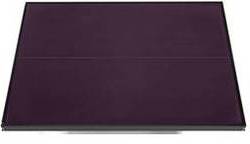Kaneka Solar was no “Johnny-come-lately” to the thin-film solar market.
The company pursued the technology in the early stages and have built up some hands-on experience over the past twenty years.
Kaneka had to accept that times were changing in October of 2011, however, when the company announced that it was suspending production of its amorphous silicon solar panels.
Why would the company decide to throw in the towel on thin-film solar panels after sticking with the technology for so many years? It likely has a lot to do with the rapidly falling price of traditional crystalline silicon solar panels.
One of the main benefits of thin-film solar panels was that they were cheaper than crystalline solar panels. Since the price of crystalline solar panels has dropped approximately forty percent over the past couple of years the thin-film advantage has disappeared.
(Especially since thin-film panels can’t keep up with crystalline panels in the solar panel efficiency department).
So has Kaneka Solar decided to pack up the company’s solar facilities and call it a day? Thankfully not.
The company has instead decided to focus on its “Hybrid PV” product line. According to Kaneka, these hybrid panels are “composed of layers of amorphous and thin-film microcrystalline silicon”. In essence, the panels are a combination of thin-film panels and traditional crystalline solar panels.
This style of panel offers a couple of advantages over other solar panel varieties. One advantage is that the panels are highly efficient due to the fact that they can absorb light from both ends of the light spectrum.
Another advantage is that the panels can still produce power when part of the panel is shaded. (The hybrid panels also keep up with the industry standard of a twenty five year warranty).
The main disadvantage of the Kaneka modules is the same disadvantage that other thin-film technologies have: Lower solar panel efficiency. When solar panels are less efficient it means that you need to install more panels to get the same power that you would get from a smaller number of crystalline solar panels.

This might not be a big deal if you can get the panels for a “cost per watt” that is competitive with other panels. If you have limited roof space, however, it can be a problem.
The American version of Kaneka Solar’s hybrid panels are available in 100 watt, 105 watt, and 110 watt varieties.
The following are the specs on Kaneka’s U-SA100 (100 watt panel).
Note: If you want to know more about what these stats mean check out solar panel info (it will open in a new window so you can go back and forth).
Now, onto the stats…
Rated Power at STC (Standard Test Conditions)
This will be the “advertised” wattage of the panel you’re looking at (e.g. 180 watt or 205 watt).
Rated Power Tolerance (%)
+10/-5
Module Efficiency (%)
8.2%
Power Warranty (Years)
25
Cell Type
Amorphous Silicon / Microcrystalline
Maximum Power Temperature Coefficient (% per °C)
-0.35
